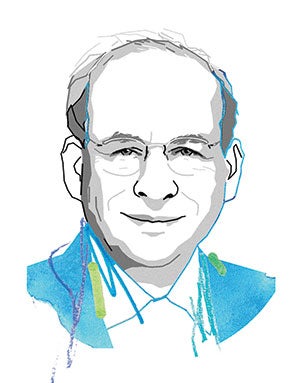Creativity: The Foundation of Human Progress
President's Note

Much of this issue is dedicated to creativity. What may be striking to some readers, but not surprising to those of us inside the university, is how central creativity is to work across the entire university. I recently visited with the faculties of the departments of BioSciences and English, whose nature of work and field of endeavor couldn’t be more different. And yet out of those visits emerged in clear and strong terms a common theme: creativity.
The English department emphasized two things in its overall goals, namely both creative and critical capacity. The critical capacity to break things down underlies the creative capability of putting them together in new ways. As the department broadly stated, “Reading literature changes how you think and who you can be.” Literature gives you the opportunity to see the human experience through someone else’s eyes or even just to see an alternative human experience. Creativity is enhanced when we break away from our own experiences and opportunities and our own ways of looking at things around us. The same is true when we are challenged to communicate in new ways. The English department is seeking to respond to surging interest in creative writing, significantly fueled by students in science and engineering.
A major effort of the Department of BioSciences has creation at its core: synthetic biology. There, the goal is “writing new DNA programs to program cells with the goal of creating technologies that transform” a wide array of areas, including medicine, energy, agriculture and manufacturing. This is radically different from the traditional study of biology, which has emphasized description and understanding of the living world.
In the new realm of biology, it’s critical that our researchers can imagine new possibilities for using living organisms to solve a wide variety of problems. Science progresses not with a passive approach to observing and learning, but with an active creative approach of imagining what we do not know, how we might go about learning it and how we could use new knowledge to create new possibilities.
Here’s what a student had to say about a course in experimental synthetic biology, “The thinking that guided this course was immensely empowering; it not only inspired me to think creatively about biological solutions to the real-world problems that matter to me, but also showed me that I can have an active role in achieving the solution.” Or, regarding BIOC 333: BioInnovation Studio, “BIOC 333 was a great chance to understand the bridge between investigative biology and inventive entrepreneurship …” And in another course on cellular and animal physiology, student teams were asked to create biologically designed fictional animals and assess whether they could survive in a radically changed future environment. Such creativity by our faculty helps instill creativity in our students. Similarly, a course at the Moody Center for the Arts combined learning the science of coral reefs with environmental art theory and practice.
Universities have sometimes been described as places where the future is invented. Creativity is not the only attribute required, of course. Accumulated human knowledge and skills, incorporated in part in technologies of discovery, are essential ingredients. Equally important is our optimism — an optimism that our creativity, our knowledge and our skills can make a difference in solving the needs of humanity, and even more broadly of life and our planet. Creativity flourishes most in environments of liberty, in part because liberty serves the curiosity and experimentation likely to lead to new and different insights and discoveries. That is certainly one of the reasons the United States has led in the creation of new technologies. But we see creativity in virtually every environment as an essential human quality. I vividly remember visiting one of the cave sites in southern France where creative animal drawings survive from 15,000 years ago.
Some years ago, I wrote a column under the heading “You Can’t Teach That.” When it comes to creativity, we beg to differ, and believe the years of both undergraduate and graduate education are critically important years in developing creative capability and inclination. And universities must put that at the center of their educational goals. Creativity is not simply one option for the success of human society; it is the foundation of human progress.
